Effect of Guarana (Paullinia cupana) on Cognitive Performance: A Systematic Review and Meta-Analysis
Abstract
1. Introduction
2. Materials and Methods
2.1. Systematic Review
2.2. Study Inclusion
2.3. Study Selection
2.4. Data Extraction and Quality Assessment
2.5. Meta-Analysis
2.6. Moderator Variables
3. Results
3.1. Study Characteristics
3.2. Overall Effect of Guarana on Cognitive Task Performance
3.3. Moderator Variable Analysis
3.3.1. Outcome Type
3.3.2. Ingestion Vehicle
3.3.3. Meta-Regression
4. Discussion
Supplementary Materials
Author Contributions
Funding
Institutional Review Board Statement
Informed Consent Statement
Data Availability Statement
Acknowledgments
Conflicts of Interest
References
- Maughan, R.J. Nutritional ergogenic aids and exercise performance. Nutr. Res. Rev. 1999, 12, 255–280. [Google Scholar] [CrossRef] [PubMed]
- Heckman, M.A.; Weil, J.; Gonzalez de Mejia, E. Caffeine (1, 3, 7-trimethylxanthine) in Foods: A Comprehensive Review on Consumption, Functionality, Safety, and Regulatory Matters. J. Food Sci. 2010, 75, R77–R87. [Google Scholar] [CrossRef] [PubMed]
- Fulgoni, V.L., III.; Keast, D.R.; Lieberman, H.R. Trends in intake and sources of caffeine in the diets of US adults: 2001–2010. Am. J. Clin. Nutr. 2015, 101, 1081–1087. [Google Scholar] [CrossRef] [PubMed]
- Schimpl, F.C.; da Silva, J.F.; Gonçalves, J.F.D.C.; Mazzafera, P. Guarana: Revisiting a highly caffeinated plant from the Amazon. J. Ethnopharmacol. 2013, 150, 14–31. [Google Scholar] [CrossRef] [PubMed]
- Torres, E.; Pinaffi-Langley, A.; Figueira, M.S.; Cordeiro, K.S.; Negrão, L.D.; Soares, M.J.; da Silva, C.P.; Alfino, M.C.Z.; Sampaio, G.R.; de Camargo, A.C. Effects of the consumption of guarana on human health: A narrative review. Compr. Rev. Food Sci. Food Saf. 2022, 21, 272–295. [Google Scholar] [CrossRef]
- Cofee, Espresso, U.S. Department of Agriculture: FoodData Central. Available online: https://fdc.nal.usda.gov/fdc-app.html#/food-details/1104140/nutrients (accessed on 14 December 2022).
- Chocolate, Dark, 70-85% Cacao Solids, U.S. Department of Agriculture: FoodData Central. Available online: https://fdc.nal.usda.gov/fdc-app.html#/food-details/170273/nutrients (accessed on 14 December 2022).
- Campos, M.P.D.O.; Riechelmann, R.; Martins, L.C.; Hassan, B.J.; Casa, F.B.A.; Del Giglio, A. Guarana (Paullinia cupana) Improves Fatigue in Breast Cancer Patients Undergoing Systemic Chemotherapy. J. Altern. Complement. Med. 2011, 17, 505–512. [Google Scholar] [CrossRef]
- del Giglio, A.B.; Cubero, D.; Lerner, T.G.; Guariento, R.T.; de Azevedo, R.G.S.; Paiva, H.; Goldman, C.; Carelli, B.; Cruz, F.M.; Schindler, F.; et al. Purified dry extract of Paullinia cupana (guaraná) (PC-18) for chemotherapy-related fatigue in patients with solid tumors: An early discontinuation study. J. Diet. Suppl. 2013, 10, 325–334. [Google Scholar] [CrossRef]
- Boozer, C.N.; Nasser, J.A.; Heymsfield, S.B.; Wang, V.; Chen, G.; Solomon, J.L. An herbal supplement containing Ma Huang-Guarana for weight loss: A randomized, double-blind trial. Int. J. Obes. Relat. Metab. Disord. 2001, 25, 316–324. [Google Scholar] [CrossRef]
- Krewer, C.D.; Ribeiro, E.E.; Ribeiro, E.A.; Moresco, R.N.; de Ugalde Marques da Rocha, M.I.; Montagner, G.F.F.S.; Machado, M.M.; Viegas, K.; Brito, E.; da Cruz, I.B.M. Habitual intake of guaraná and metabolic morbidities: An epidemiological study of an elderly Amazonian population. Phytother. Res. 2011, 25, 1367–1374. [Google Scholar]
- de Araujo, D.P.; Pereira, P.T.V.T.; Fontes, A.J.C.; Marques, K.D.S.; de Moraes, B.; Guerra, R.N.M.; Garcia, J.B.S. The use of guarana (Paullinia cupana) as a dietary supplement for fatigue in cancer patients: A systematic review with a meta-analysis. Support. Care Cancer 2021, 29, 7171–7182. [Google Scholar] [CrossRef]
- Fredholm, B.B. Are methylxanthine effects due to antagonism of endogenous adenosine? Trends Pharmacol. Sci. 1979, 1, 129–132. [Google Scholar] [CrossRef]
- McLellan, T.M.; Caldwell, J.A.; Lieberman, H.R. A review of caffeine’s effects on cognitive, physical and occupational performance. Neurosci. Biobehav. Rev. 2016, 71, 294–312. [Google Scholar] [CrossRef]
- Fredholm, B.B. Astra Award Lecture. Adenosine, adenosine receptors and the actions of caffeine. Pharm. Toxicol. 1995, 76, 93–101. [Google Scholar] [CrossRef] [PubMed]
- Galduróz, J.C.; Carlini, E.D. Acute effects of the Paulinia cupana, "Guaraná" on the cognition of normal volunteers. Sao. Paulo. Med. J. Rev. Paul. Med. 1994, 112, 607–611. [Google Scholar] [CrossRef] [PubMed]
- Kennedy, D.; Haskell, C.; Wesnes, K.; Scholey, A. Improved cognitive performance in human volunteers following administration of guarana (Paullinia cupana) extract: Comparison and interaction with Panax ginseng. Pharmacol. Biochem. Behav. 2004, 79, 401–411. [Google Scholar] [CrossRef]
- Haskell, C.F.; Kennedy, D.O.; Wesnes, K.A.; Milne, A.L.; Scholey, A.B. A double-blind, placebo-controlled, multi-dose evaluation of the acute behavioural effects of guaraná in humans. J. Psychopharmacol. 2007, 21, 65–70. [Google Scholar] [CrossRef]
- Kennedy, D.O.; Haskell, C.F.; Robertson, B.; Reay, J.; Brewster-Maund, C.; Luedemann, J.; Maggini, S.; Ruf, M.; Zangara, A.; Scholeyet, A.B. Improved cognitive performance and mental fatigue following a multi-vitamin and mineral supplement with added guaraná (Paullinia cupana). Appetite 2008, 50, 506–513. [Google Scholar] [CrossRef]
- Scholey, A.; Bauer, I.; Neale, C.; Savage, K.; Camfield, D.; White, D.; Maggini, S.; Pipingas, A.; Stough, C.; Hughes, M. Acute effects of different multivitamin mineral preparations with and without Guaraná on mood, cognitive performance and functional brain activation. Nutrients 2013, 5, 3589–3604. [Google Scholar] [CrossRef]
- Veasey, R.C.; Haskell-Ramsay, C.F.; Kennedy, D.O.; Wishart, K.; Maggini, S.; Fuchs, C.; Stevenson, E. The Effects of Supplementation with a Vitamin and Mineral Complex with Guaraná Prior to Fasted Exercise on Affect, Exertion, Cognitive Performance, and Substrate Metabolism: A Randomized Controlled Trial. Nutrients 2015, 7, 6109–6127. [Google Scholar] [CrossRef]
- Penna, E.M.; Harp, A.; Hack, B.; Talik, T.; Millard-Stafford, M. Acute Effects of Guarana Ingestion Compared to Matched Dose Caffeine: Mental Performance Benefits? In Proceedings of the Southeast American College of Sports Medicine Annual Meeting, Greenville, SC, USA, 23–25 February 2023. [Google Scholar]
- White, D.; Camfield, D.; Maggini, S.; Pipingas, A.; Silberstein, R.; Stough, C.; Scholey, A. The effect of a single dose of multivitamin and mineral combinations with and without guaraná on functional brain activity during a continuous performance task. Nutr. Neurosci. 2017, 20, 8–22. [Google Scholar] [CrossRef]
- Dennehy, C.E.; Tsourounis, C.; Miller, A.E. Evaluation of herbal dietary supplements marketed on the internet for recreational use. Ann. Pharm. 2005, 39, 1634–1639. [Google Scholar] [CrossRef]
- Nehlig, A.; Daval, J.-L.; Debry, G. Caffeine and the central nervous system: Mechanisms of action, biochemical, metabolic and psychostimulant effects. Brain Res. Rev. 1992, 17, 139–170. [Google Scholar] [CrossRef]
- Bell, L.; Lamport, D.J.; Butler, L.T.; Williams, C.M. A Review of the Cognitive Effects Observed in Humans Following Acute Supplementation with Flavonoids, and Their Associated Mechanisms of Action. Nutrients 2015, 7, 10290–10306. [Google Scholar] [CrossRef] [PubMed]
- Pomportes, L.; Brisswalter, J.; Casini, L.; Hays, A.; Davranche, K. Cognitive Performance Enhancement Induced by Caffeine, Carbohydrate and Guarana Mouth Rinsing during Submaximal Exercise. Nutrients 2017, 9, 589. [Google Scholar] [CrossRef] [PubMed]
- Meyer, K. Ball, Psychological and Cardiovascular Effects of Guaraná and Yerba Mate: A Comparison with Coffee. Rev. Interam. Psicol. 2004, 38, 87–94. [Google Scholar]
- Page, M.J.; McKenzie, J.E.; Bossuyt, P.M.; Boutron, I.; Hoffmann, T.; Mulrow, C.; Shamseer, L.; Tetzlaff, J.; Akl, E.; Brennan, S.; et al. The PRISMA 2020 statement: An updated guideline for reporting systematic reviews. BMJ 2021, 372, n71. [Google Scholar] [CrossRef] [PubMed]
- Moseley, A.M.; Herbert, R.D.; Sherrington, C.; Maher, C.G. Evidence for physiotherapy practice: A survey of the Physiotherapy Evidence Database (PEDro). Aust. J. Physiother. 2002, 48, 43–49. [Google Scholar] [CrossRef] [PubMed]
- Horowitz, I.; Avirame, K.; Naim-Feil, J.; Rubinson, M.; Moses, E.; Gothelf, D.; Levit-Binnun, N. The interactive effects of test-retest and methylphenidate administration on cognitive performance in youth with ADHD: A double-blind placebo-controlled crossover study. Psychiatry Res. 2020, 291, 113056. [Google Scholar] [CrossRef]
- Soveri, A.; Lehtonen, M.; Karlsson, L.C.; Lukasik, K.; Antfolk, J.; Laine, M. Test–retest reliability of five frequently used executive tasks in healthy adults. Appl. Neuropsychol. Adult 2016, 25, 155–165. [Google Scholar] [CrossRef]
- Borenstein, M.; Hedges, L.V.; Higgins, J.P.; Rothstein, H.R. Introduction to Meta-Analysis; Wiley & Sons, Ltd: Hoboken, NJ, USA, 2009; ISBN 978-0470057247. [Google Scholar]
- Pomportes, L.; Brisswalter, J.; Hays, A.; Davranche, K. Effects of Carbohydrate, Caffeine, and Guarana on Cognitive Performance, Perceived Exertion, and Shooting Performance in High-Level Athletes. Int. J. Sports Physiol. Perform. 2019, 14, 576–582. [Google Scholar] [CrossRef]
- Pomportes, L.; Davranche, K.; Brisswalter, I.; Hays, A.; Brisswalter, J. Heart Rate Variability and Cognitive Function Following a Multi-Vitamin and Mineral Supplementation with Added Guarana (Paullinia cupana). Nutrients 2014, 7, 196–208. [Google Scholar] [CrossRef] [PubMed]
- Fiani, B.; Zhu, L.; Musch, B.L.; Briceno, S.; Andel, R.; Sadeq, N.; Ansari, A. The Neurophysiology of Caffeine as a Central Nervous System Stimulant and the Resultant Effects on Cognitive Function. Cureus 2021, 13, e15032. [Google Scholar] [CrossRef]
- Lorist, M.M.; Snel, J.; Kok, A.; Mulder, G. Acute effects of caffeine on selective attention and visual search processes. Psychophysiology 1996, 33, 354–361. [Google Scholar] [CrossRef]
- Van Duinen, H.; Lorist, M.M.; Zijdewind, I. The effect of caffeine on cognitive task performance and motor fatigue. Psychopharmacology 2005, 180, 539–547. [Google Scholar] [CrossRef]
- Durlach, P.J. The effects of a low dose of caffeine on cognitive performance. Psychopharmacology 1998, 140, 116–119. [Google Scholar] [CrossRef]
- Smith, A.P. Caffeine, extraversion and working memory. J. Psychopharmacol. 2013, 27, 71–76. [Google Scholar] [CrossRef]
- Kennedy, D.O.; Wightman, E.L. Mental Performance and Sport: Caffeine and Co-consumed Bioactive Ingredients. Sports Med. 2022, 52 (Suppl. 1), 69–90. [Google Scholar] [CrossRef] [PubMed]
- Edwards, H.G.; Farwell, D.W.; de Oliveira, L.F.; Alia, J.-M.; Le Hyaric, M.; de Ameida, M.V. FT-Raman spectroscopic studies of guarana and some extracts. Anal. Chim. Acta 2005, 532, 177–186. [Google Scholar] [CrossRef]
- Yoshizawa, S.; Horiuchi, T.; Fujiki, H.; Yoshida, T.; Okuda, T.; Sugimura, T. Antitumor promoting activity of (−)-epigallocatechin gallate, the main constituent of “Tannin” in green tea. Phytother. Res. 1987, 1, 44–47. [Google Scholar] [CrossRef]
- Hopewell, S.; McDonald, S.; Clarke, M.J.; Egger, M. Grey literature in meta-analyses of randomized trials of health care interventions. Cochrane Database Syst. Rev. 2007, 2010, MR000010. [Google Scholar] [CrossRef]
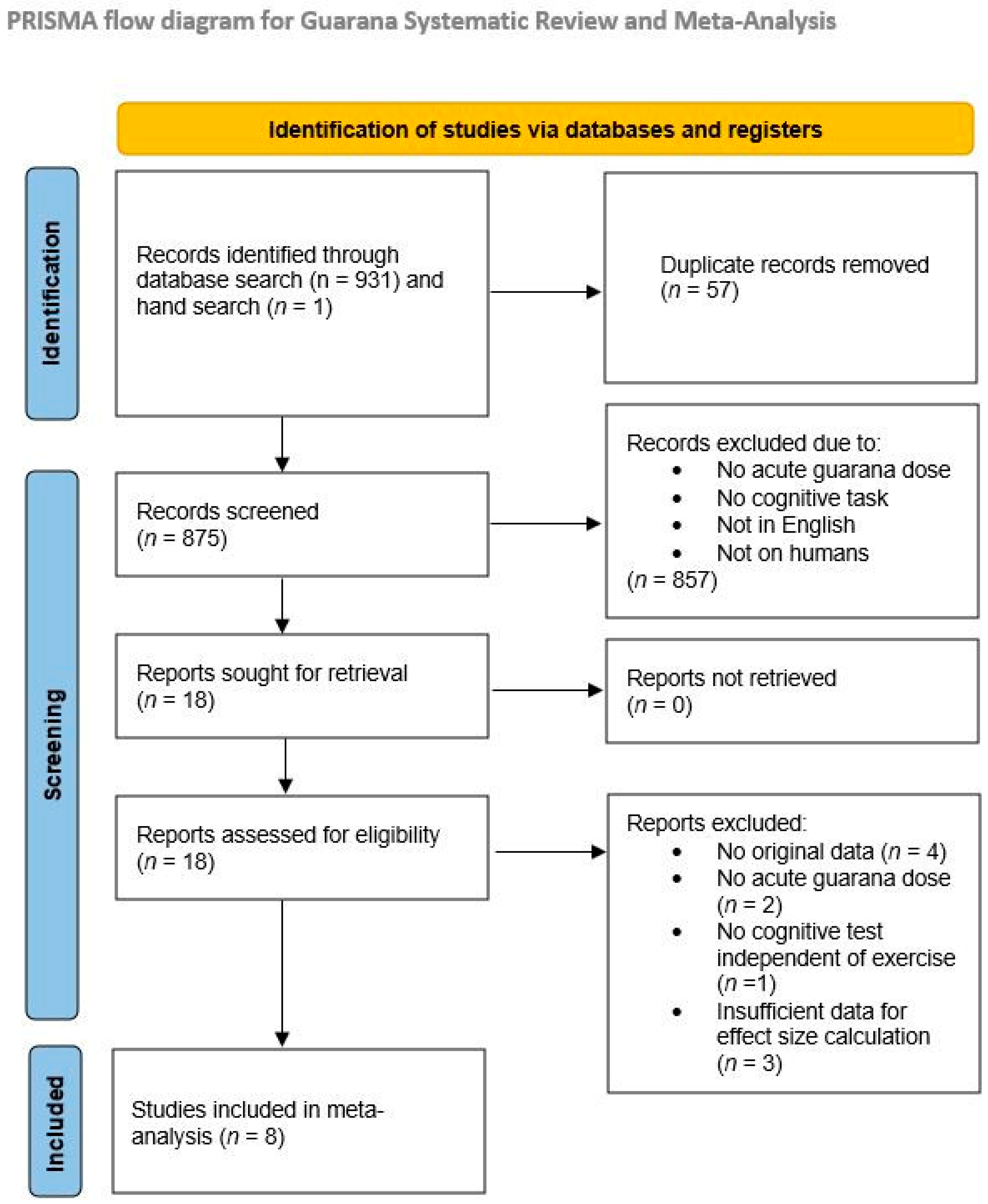

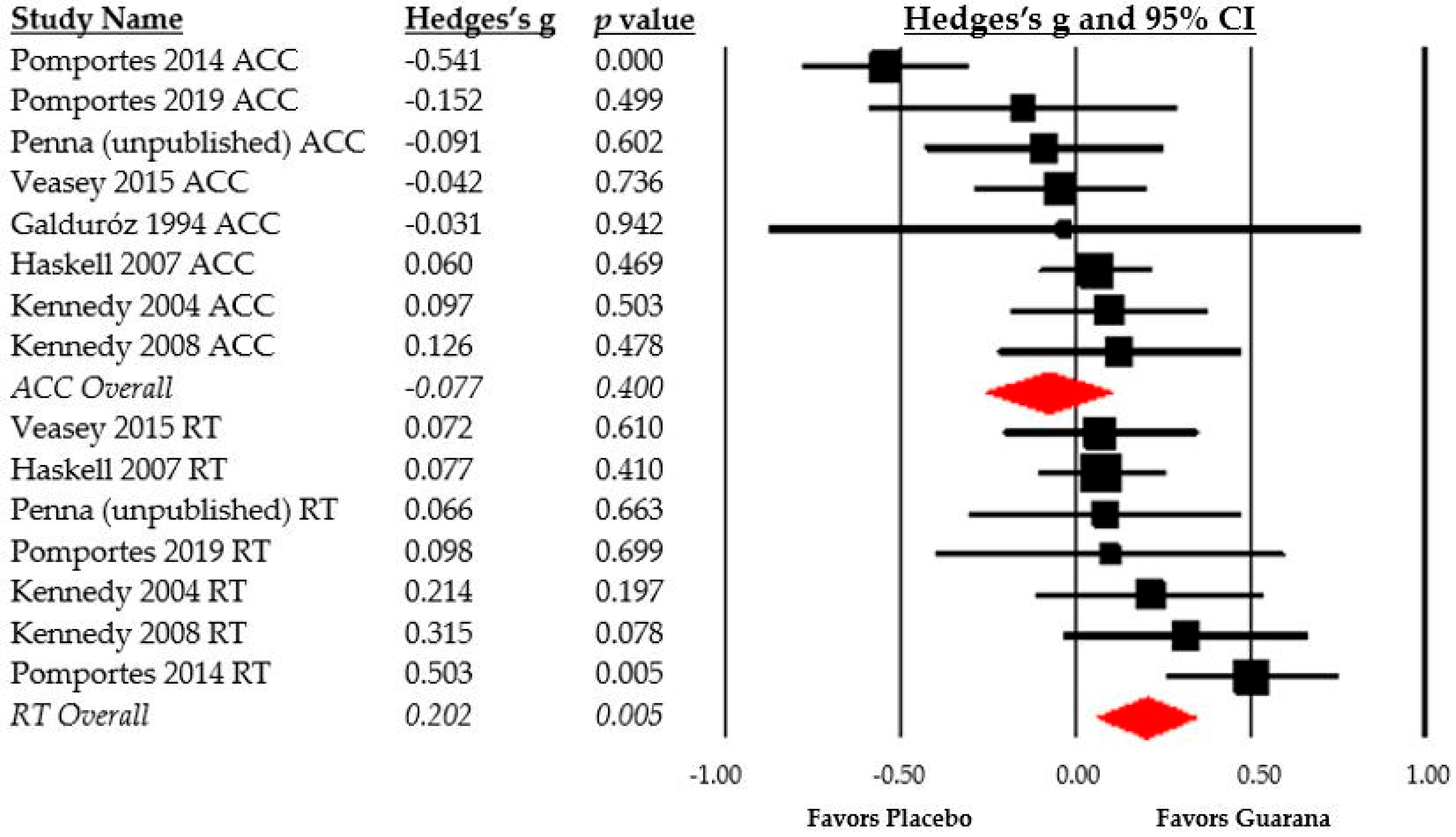
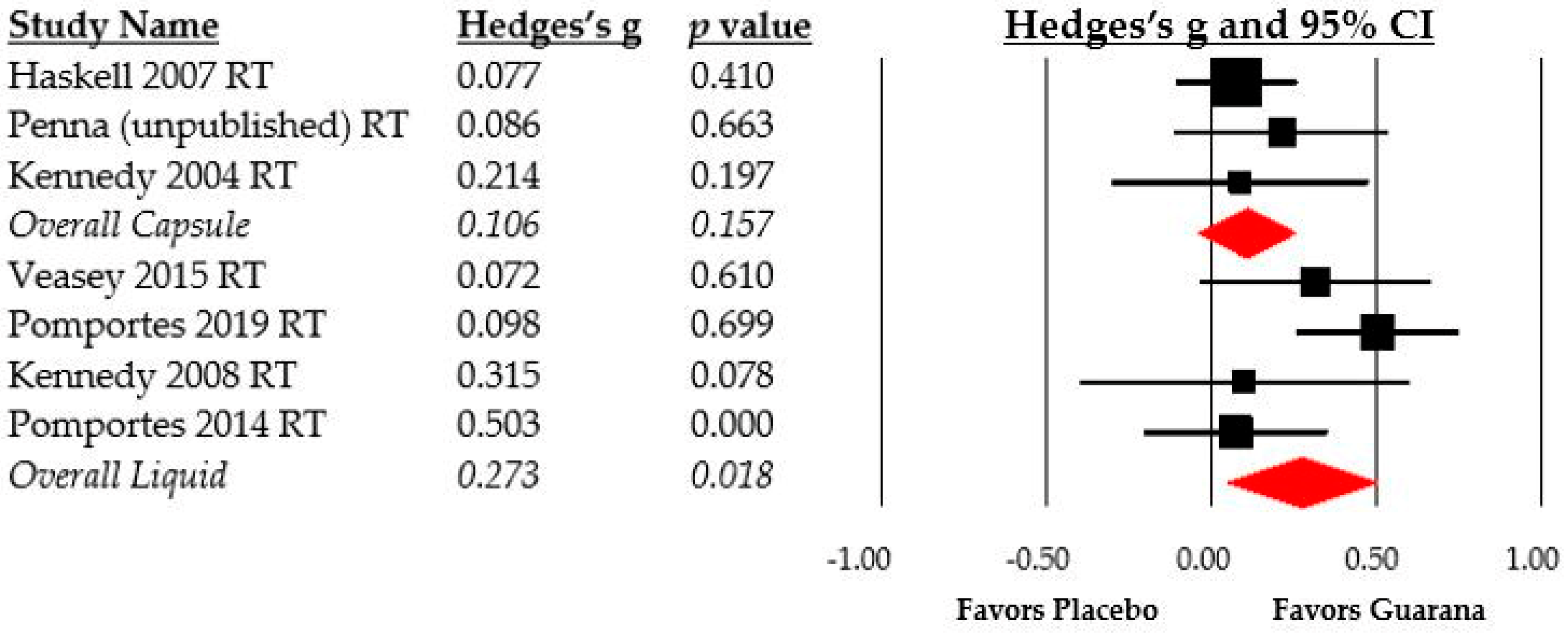
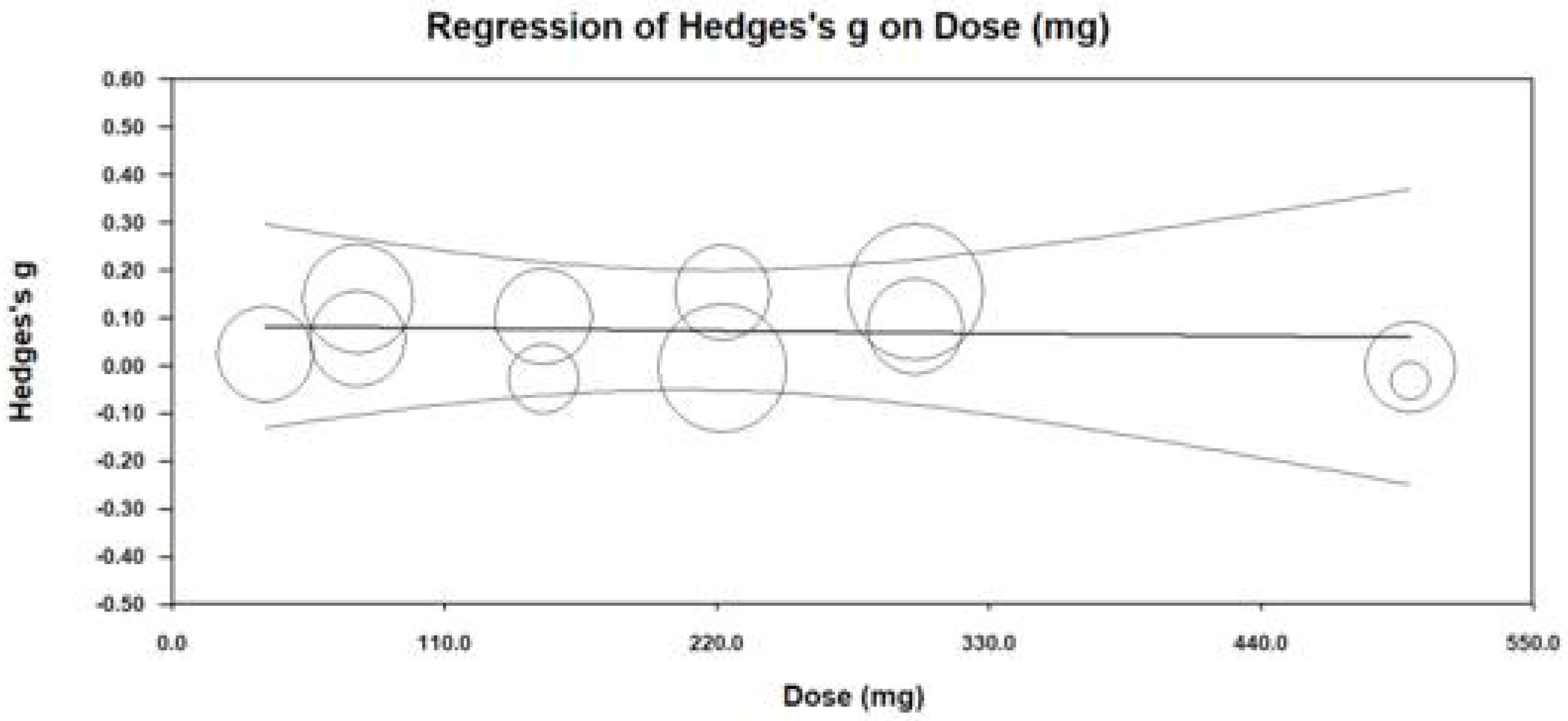
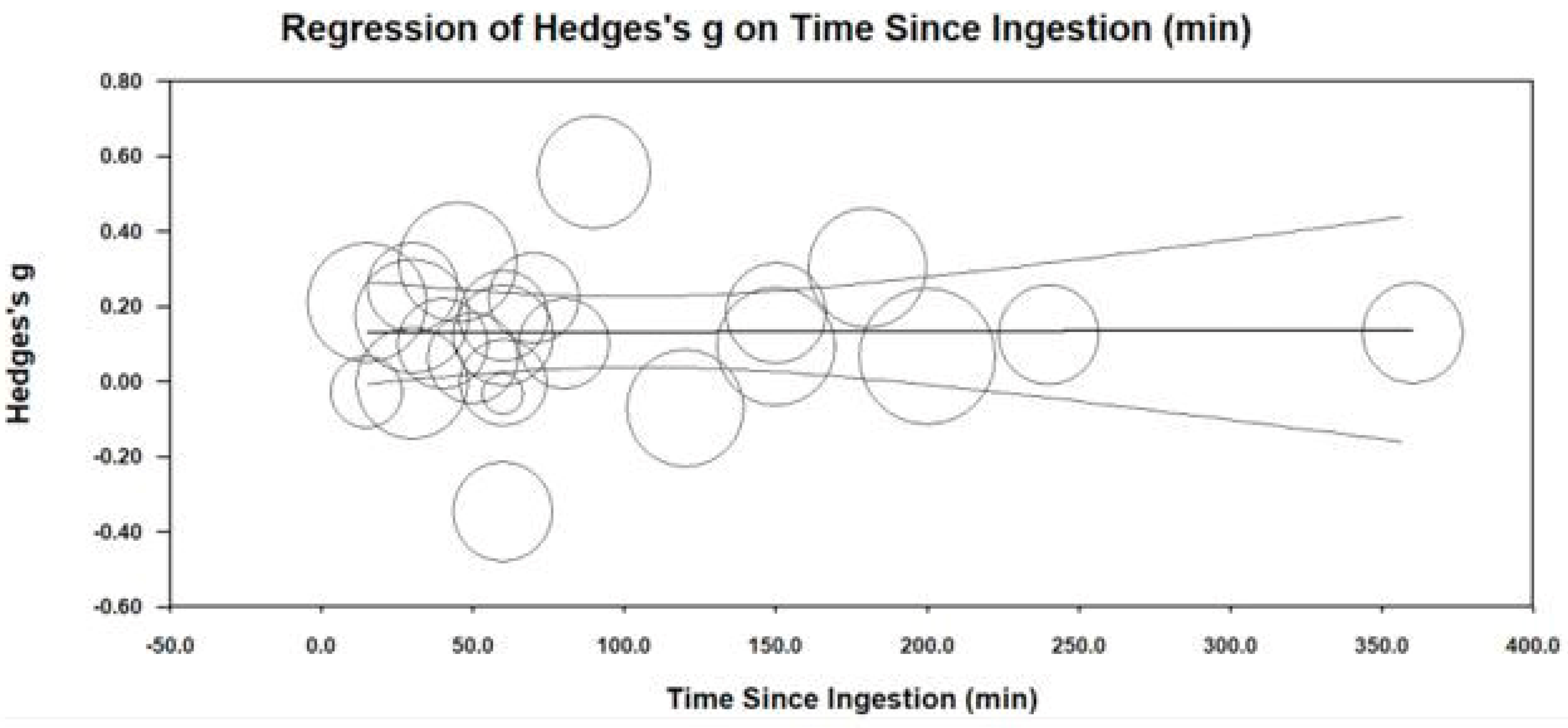
Disclaimer/Publisher’s Note: The statements, opinions and data contained in all publications are solely those of the individual author(s) and contributor(s) and not of MDPI and/or the editor(s). MDPI and/or the editor(s) disclaim responsibility for any injury to people or property resulting from any ideas, methods, instructions or products referred to in the content. |
© 2023 by the authors. Licensee MDPI, Basel, Switzerland. This article is an open access article distributed under the terms and conditions of the Creative Commons Attribution (CC BY) license (https://creativecommons.org/licenses/by/4.0/).
Share and Cite
Hack, B.; Penna, E.M.; Talik, T.; Chandrashekhar, R.; Millard-Stafford, M. Effect of Guarana (Paullinia cupana) on Cognitive Performance: A Systematic Review and Meta-Analysis. Nutrients 2023, 15, 434. https://doi.org/10.3390/nu15020434
Hack B, Penna EM, Talik T, Chandrashekhar R, Millard-Stafford M. Effect of Guarana (Paullinia cupana) on Cognitive Performance: A Systematic Review and Meta-Analysis. Nutrients. 2023; 15(2):434. https://doi.org/10.3390/nu15020434
Chicago/Turabian StyleHack, Brian, Eduardo Macedo Penna, Tyler Talik, Rohan Chandrashekhar, and Mindy Millard-Stafford. 2023. "Effect of Guarana (Paullinia cupana) on Cognitive Performance: A Systematic Review and Meta-Analysis" Nutrients 15, no. 2: 434. https://doi.org/10.3390/nu15020434
APA StyleHack, B., Penna, E. M., Talik, T., Chandrashekhar, R., & Millard-Stafford, M. (2023). Effect of Guarana (Paullinia cupana) on Cognitive Performance: A Systematic Review and Meta-Analysis. Nutrients, 15(2), 434. https://doi.org/10.3390/nu15020434





